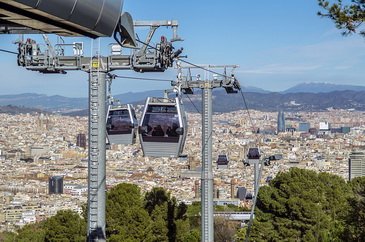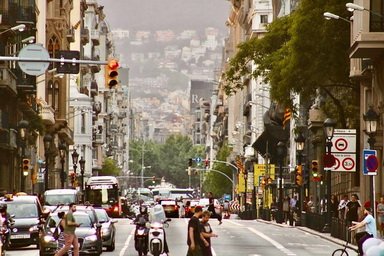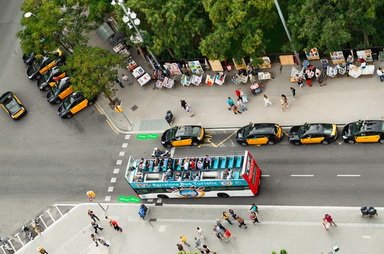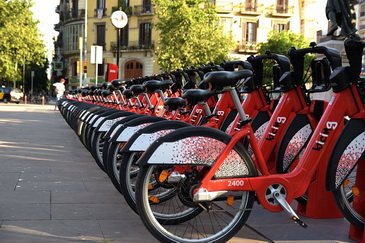B
arcelona may not be the capital of Spain but has second place in the ranking. And then, the Catalan people have a completely different opinion, but this is another story.
It is a densely populated city, that could be an example for others. It is well organized, with wide, fast arteries leading traffic through the middle of the city. They offer possibilities to turn left and right, to smaller streets, where you quickly find the place, you are searching for. You may need a moment to get used to the idea of the one-way streets, but it makes sense after a while. There is a vein going north, and just behind a row of tenements is another one leading south. The town plan is like a checkboard – easy to follow and read.
The Catalan people drive calmly and safely (maybe except the taxi drivers, but they are always in a hurry). After some getting used to it, you will easily use a scooter there or ride a bike. The busses are the same as everywhere else – with some advantages but can get stuck in traffic. There is also an option for those wanting speed and a reasonable price – the local metro network is fabulous.
What is the most important, Barcelona offers the thing that is the best for a tourist. The attractions tend to be grouped in a walkable area! So, forget about public transport, wander around and see the most of it. Like a walk from Barrio Gothic, following La Rambla Street straight to the port. Or around Montjüic, its Olympic City, and down to the Magic Fountains.
There are places located a bit too far. Metro will be your best option. Those who love football will have to travel to Camp Nou. Sagrada Familia is in a nice area, but you mainly go there for her and nothing else. The same goes for Park Guell, which is on a hill and feels the furthest away.
Depending on how much time you have and what you want to see, you will have to plan a little. For most of us – the metro and walking are sufficient. Those loving architecture, will prefer busses or hop on and off busses. A scooter may be a good idea unless you are a designated driver.
You will certainly find your way.

Let us start with the information that Barcelona has an integrated network system. One ticket covers all means of transport. Hola Barcelona is a card with the airport transfer included. The locals prefer the TMB tickets (Public transport of Barcelona) – mostly because they are designed for them and not for tourists… but there are some exceptions.
Hola Barcelona!!!
You can take it for a minimum of 2 days, up to 5 days. The clock starts with the first validation and then respectfully 48-120 hours.
What is important is that you get everything – busses, trams, metro, zone 1 urban trains, and RENFE trains and funicular to Montjüic (not the cable car going over the port!).
Prices
2 days (48h) – 16,30 €
3 days (72h) – 23,70 €
4 days (96h) – 30,80 €
5 days (120h) – 38 €
Where do you get them?
You can buy the tickets at the airport – directly from the vending machine. You can also buy it online, get the code, input the code into the very same machines and it will be printed for you there.
As for “in the city” – try the metro stations.
T-tickets
The same red-grey automates offer you the public transport of Barcelona tickets (TMB – Transports Metropolitans de Barcelona).
T-series also cover the whole public transport, and you can interchange as much as you want. You just need to remember that a single ticket is valid for a period of 75 minutes.
The most popular is the T-casual, which offers to one person 10 single rides (a group ticket for 8 rides is called T-familiar). T-group is a 70-ride version of the these tickets, but if you do the calculations, the price is the same (it may probably be useful for guides or big groups of friends). All the main attractions are in zone 1, so there is no need to buy the upgraded versions.
The day ticket (24h) makes sense only if you do at least 5 rides in a day. It is a ticket with the airport ride included, but it is not worth its price. El Prat is in zone 4, so you will need to buy a day ticket for 4 zones.
T-usual, T-jove are the tickets for the locals, since you have to have a proper ID or stay there at least a month and travel frequently.
Prices
Single ride (1 zone) – 2,40 €
Single ride (5 zones, eg. To Blanes) – 7,35 €
T-Casual (1 zone only) – 11,35 €
T-Familiar – 10 €
T-dia (1 zone) – 10,50 €

Since a one-way ticket to/from the airport is around 5,15€ (on how to get to/from there read here) and a single fare for a bus/metro/tram in Zone 1 is 2,40€ you can see, that T-casual makes a lot of sense… When you think about it, when you are there, you just want to see… and experience… Somehow you forget about your legs hurting until the end of the day.
From personal experience… we like to take similar tickets everywhere because we often do a maximum of 3 rides per day meaning… to/from hotel and somewhere in the middle of the day.
Now that we know that one piece of paper covers everything, what is this everything?
Metro and trains
The rail system of Barcelona is the most popular among the citizens. There are 12 lines altogether (they are operated by 2 companies – TMB and FGC). Within the integrated ticket, you can also use the trains of Rodalies de Catalunya (RENFE).
Here you will find a link to a map…
The city of Barcelona is contained within the first zone and, as a tourist, you rarely need to buy a ticket for more. This way the “limit of Zone 1 only” (as for the trains) will be of no concern to you. The travels to other places of interest will be covered elsewhere.
As it was stated previously, a single journey lasts 75 minutes. There will be some red-grey machines at the stops that will allow you to buy any ticket you want.
It is imperative to remember to always validate and guard the ticket.
You should also be aware of the thieves, which love to roam the metro, especially when there are crowds.
Metro has a very logical timetable. Within the week and on Sunday evenings it works between 5 AM and midnight. On Friday and Saturday nights, when people tend to go to have fun, it runs all night!
There is always a special schedule for festivities, so check the calendar before you go.
Trams and Funicular
A quick word about the tram should be included. They cover the Besòs and Llobregat regions and it is unlikely that they will be your primary target for moving around the city. But if you happen to need a quick ride and they are there… they are included. They work from 5 AM till midnight (Fridays and Saturdays till 2 AM).
It is more probable that you will use the funicular to Montjuic. With your tickets, you can only use the one connecting the metro station Parallel and Av. Miramar. You will arrive at a halfway point. From there you can walk to the peak and the castle or buy a ticket for the adjacent cable car.
 Important! Teleferico de Montjuïc is not the same as the Aeri del Port! The first one allows you to climb the hill easier. The other one is the famous red cabin gliding over the port and offering stunning views.
Important! Teleferico de Montjuïc is not the same as the Aeri del Port! The first one allows you to climb the hill easier. The other one is the famous red cabin gliding over the port and offering stunning views.
Buses
There are over 100 routes in Barcelona and the network covers all the city and the adjacent suburbs.
You may want to avoid it during the day since they can often be stuck in traffic (especially in the go-to work/back-from work periods).
But you will want to remember about them during the night. When the metro stops running, there is always a night bus that can take you back to your hotel. Although we must admit here – sometimes waiting for the night bus can be so long…
Then – you can always take the yellow-black taxi. They may be expensive, but in a group or in need they are perfect. Taxi in Barcelona is a well-organized system, there will be no scams, and the prices are always the same. And no… UBER is illegal in the city, so forget about it.
Hop on and off buses
This should be a separate paragraph here since in Barcelona it is quite useful.
Yes, it is a bus, and as it was stated before, it will be stuck in traffic. But the open roof is worth it… the beauty of the local architecture will stun you. It is the city of Gaudi after all! What is more, Barcelona is a modern city, where old ideas coexist in harmony with the new ones and they both welcome some eccentricity to spice everything up.
The only problem is running in circles and from 9 AM till 7/8 PM. It limits your ideas and makes you really plan your day.
There are two companies in Barcelona – the official one is Bus Turistic (3 lines). But there is also a well-known Citysightseeing Bus Tour Group (2 lines). Both companies cover all the tourist spots in the city. They also offer various discounts… Some say that the Bus Turistic is better in this department.
Visit their websites for more information and check their maps here (BT) and here (CS).
Bike, motorbike, and scooter
Rental shops of this sort are quite popular in Spain. You do not have to rely on the city bike network, which often requires us to have a monthly pass or something else… It varies from one place to the next.
The bike is a popular means of transport since Barcelona is rather a flat city. Some attractions are further away, that is true. But in these situations, you can always take an electric bike. There are many companies that can offer you their services (Mattias 46, Barcelona Rent a bike, Bike Tour Barcelona).
As for the scooters… the lovely Vespas are growing in popularity from one year to the next. Especially the Italian dream of a red one, gliding alongside the seashore… It does look great on photos too. There are many places to rent (Via Vespa, Cooltra) and some rental companies are compared here.
The price is always better if you take it for days, not hours. You can close everything in about 40-50 € for 2 days.
 In both examples remember about the thieves. Take additional insurance and always remember to use the lock that is provided by the companies. And wear the helmet on a scooter or you will get a ticket.
In both examples remember about the thieves. Take additional insurance and always remember to use the lock that is provided by the companies. And wear the helmet on a scooter or you will get a ticket.
Smaller vehicles will give you a lot of opportunities to look around you and stop if you see something interesting. They also ignore the traffic quite nicely. Just drive consciously, be careful and watch the road… safety first!







